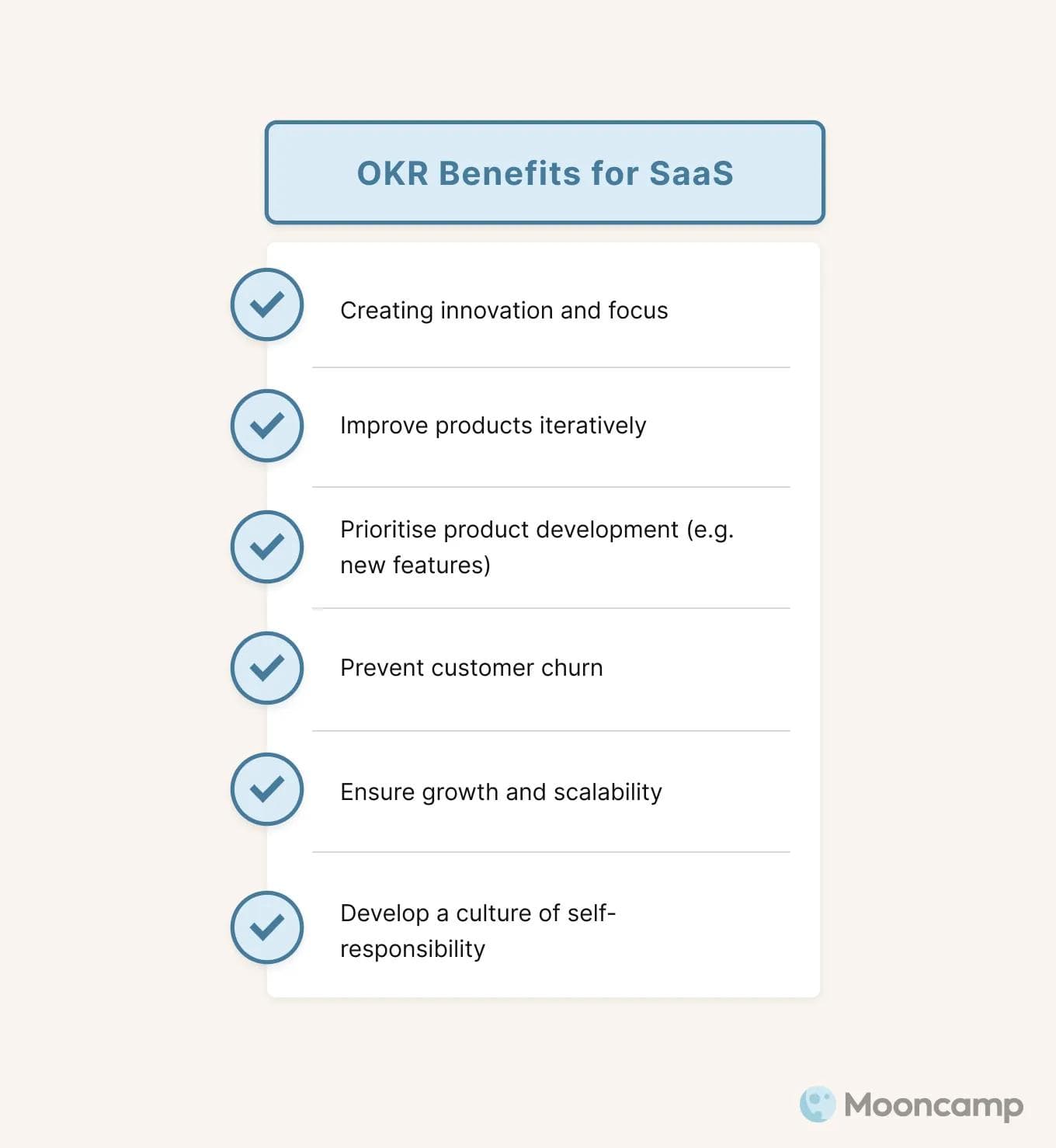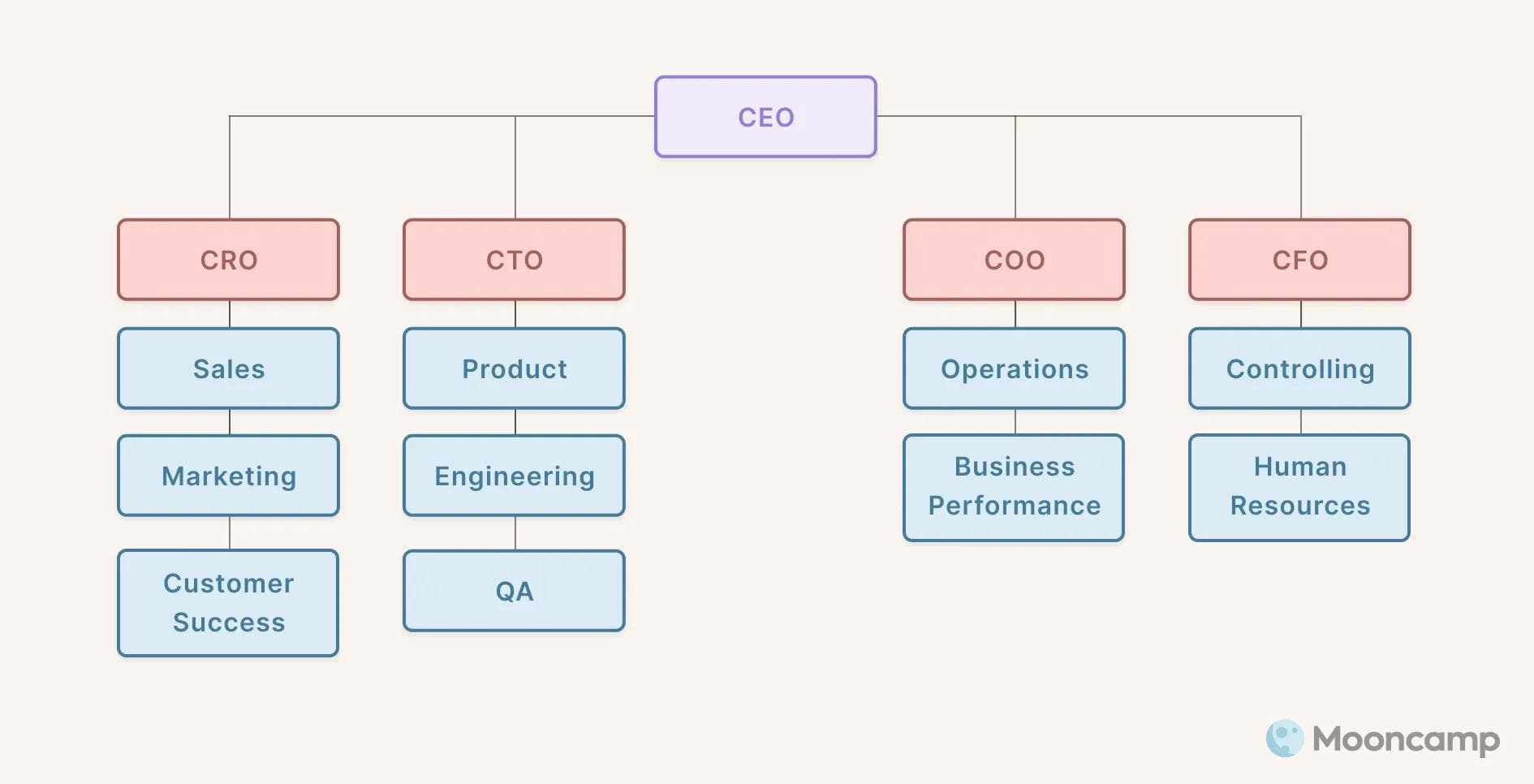OKRs for SaaS: 15 real-world examples

OKRs align teams, measure progress and drive innovation. This makes them not just a trend, but a strategic imperative for SaaS companies.
We have summarised everything about why OKRs are so important for SaaS as well as concrete examples from real life in this article.
What you can expect:
- What are OKRs?
- Why are OKRs important for SaaS companies?
- Structure for growth with OKRs: how SaaS companies are organised
- 15 examples of SaaS OKRs
- Conclusion: More successful with SaaS OKRs
What are OKRs?
OKR is an acronym for "Objectives and Key Results". It is an agile framework that supports companies in formulating and implementing strategic goals. It consists of three core elements:
- Objectives: What do I want to achieve?
- Key Results: How do I know that the objective has been achieved?
- Initiatives: How do I achieve the goal?
The OKRs are always set for a specific period (usually a quarter) and are regularly reviewed and adjusted during this period. Usually 2 to 4 Objectives are formulated per team and 2 to 4 result-orientated Key Results per Objective. The output is mapped in initiatives (= concrete activities).
💡 Tip: More basic knowledge can be found in our Guide to the OKR method. Our article "Formulating OKRs: Tips for really good Objectives and Key Results" provides all the criteria for good Objectives and Key Results as well as specific formulation tips.
Why are OKRs important for SaaS companies?
The SaaS industry is growing and developing rapidly. The market is already oversaturated and established companies are dividing up the majority of the market among themselves. The result is an extremely competitive environment in which it can be difficult for new companies to assert themselves. Standing out from the crowd therefore requires constant adaptation and new ideas. In particular, SaaS companies must keep pace with technological innovations, likea AI, and offer a superior user experience.
All of this requires a high degree of flexibility, innovation and scalability. OKRs address precisely these issues. Used correctly, they are therefore important and helpful for SaaS companies for several reasons.
Specifically, OKRs can help SaaS companies,
- focus on specific innovation goals and join forces within the team.
- improve products iteratively and incorporate customer feedback in a targeted manner.
- always work on the features that provide the most value to users and align with the company's long-term vision.
- optimize SaaS metrics and find the right balance between growth and profitability.
- foster cross-functional collaboration by ensuring everyone is working towards common goals.
- increase customer satisfaction, retain them for the long term and prevent high churn rates.
- define clear goals for growth and achieve them - whether it's acquiring new customers, growing sales or expanding into new markets.
- develop a culture of self-responsibility and increase the overall performance of the company.
- make high standards of compliance and safety a priority.

Structure for growth with OKRs: This is how the majority of SaaS companies is structured
Before we get to the specific OKR examples that SaaS companies can use to achieve their goals in today's fast-paced business world, let's take a quick look at how SaaS companies are typically structured:
- What teams are there?
- What goals and tasks do the teams have?
- Which metrics are relevant for which teams?
Although there is no one-size-fits-all approach for SaaS OKRs, the typical tasks and objectives per team can be used to determine which OKRs are suitable for whom. The metrics also provide an initial orientation for suitable Key Results.
SaaS companies should also always formulate initiatives for which it is clear how they contribute to the success (or failure) of the company. Clearly assigned responsibilities, a clear vision and bundled communication - for example via specially set up Slack channels or a specialised OKR tool such as Mooncamp - also help to successfully implement the OKRs.
💡 Tip: OKRs should always be outcome-orientated in order to really achieve results. However, output-orientated OKRs can also be useful for some teams or topics. It is important that SaaS companies understand what they are achieving with which approach. You can read more about the difference between output vs. outcome on our blog.
We generally differentiate between business teams and internal teams.
Business teams
There are four central business teams in total:
- Business Development: The central task of the team is to acquire new prospects (leads) in order to generate growth and sales. Marketing: In a marketing-led (rather than sales-led) company, the marketing team takes on the tasks of the business development team. Sales: The sales team is responsible for converting leads into paying customers (e.g. with demos and meetings) and handling contracts.
- Revenue Operations: The Revenue Operations team focuses on maximising revenue efficiency by strategically aligning sales, marketing and customer service. It analyses data and processes to optimise revenue growth and customer retention.
- Customer Success: This team ensures that customers are satisfied with the product in the long term. The Customer Success Managers stay in regular contact with customers, gather feedback, lay the foundations for cross-selling and upselling and ensure that no one churns.
Each team is measured by different metrics. These are the most important at a glance:
Team | Metrics |
|---|---|
Business Development | e.g. Trials, Marketing Qualified Leads (MQL), Average Cost-per-Lead, Customer Acquisition Cost (CAC) |
Marketing | e.g. Trials, Marketing Qualified Leads (MQL), Average Cost-per-Lead, Customer Acquisition Cost (CAC) |
Sales | e.g. Trials, Sales Qualified Leads (SQL), Sales Opportunities, Number of Demo Calls, Sales Conversion Rate, Sales Cycle Length, Lead Response Time, Trial Conversion Rate, Lead-to-Win Rate, Deals Won/Lost |
Revenue Operations | e.g. Customer Lifetime Value (CLV), Delivery Time |
Customer Success | e.g. Customer Lifetime Value (CLV), Customer Churn, Customer Retention Rate, Customer Engagement Score, Customer Satisfaction Score, Referrals |
Internal teams
These three internal teams are also important:
- Product: The product team is responsible for the conceptual design of the products. They work closely with customers and internal teams to identify needs, develop product strategies and ensure that products fulfil market requirements and offer real added value.
- Engineering: The engineering team, consisting of software developers, works closely with the product managers and implements features technically. They also maintain the software, solve technical problems and ensure the scalability and security of the systems.
- Human Resources (HR): The HR team consists of HR managers and recruiters who take care of all important HR-related processes.
Different metrics are also relevant for the internal teams:
Team | Metrics |
|---|---|
Product | e.g. daily/monthly active users, average usage time |
Engineering | e.g. development time, application response time, utilisation rate for new functions, time to market for new versions |
Human Resources | e.g. employee engagement, employee satisfaction score, employee net promoter score (eNPS), sick days |

15 examples of SaaS OKRs
To help you get started, we have put together some examples of SaaS OKRs here.
💡 Note: We always recommend writing your own OKRs. However, the examples here can be a good source of inspiration. You can find even more OKR examples from real companies on our website.
🌍 Company-level OKRs
💸 Sales
💪 Customer Success
🌱 Marketing
💻 Product Management
Conclusion: More successful with SaaS OKRs
Overall, OKRs are crucial for SaaS companies that want to grow sustainably. Setting Objectives and identifying suitable Key Results ensures strategic focus and a clear direction. In addition, OKRs can help to establish a culture of self-responsibility that will drive the company forward in the long term.
SaaS companies should focus primarily on outcome-orientated OKRs and be careful to set realistic goals at the outset. Regular OKR check-ins are also the key to success with OKRs. In this way, SaaS companies create commitment and help to firmly anchor the agile mindset and OKRs in the minds of employees.
As a result, the new framework is better accepted by all employees and can realise its full potential. Starting small and scaling OKRs over time is therefore essential.
💡 Use the OKR SaaS tool: How Mooncamp supports
For the first steps in individual teams, OKR templates are usually sufficient. As soon as it comes to rolling out OKRs for the entire company, specialised OKR software such as Mooncamp is the best choice:
- OKR software ensures transparency and facilitates alignment.
- It bundles communication around OKRs and thus enables better collaboration.
- It makes it easier to manage OKRs - replacing cumbersome Excel spreadsheets and tools that are not fit for purpose.
- It ensures that everyone keeps an eye on their OKRs through integrated check-ins and regular reminders.
- It provides an overview of progress at all times and allows data to be filtered and analyzed.

